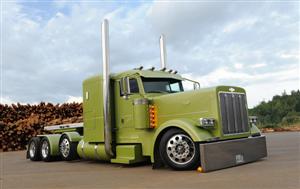COVER FEATURE - DECEMBER 2010
MAXI COOL!
HAULING “MAXI FREIGHT” WITH A COOL COMBO
By Daniel J. Linss - Editor
Hauling “maxi freight” up in the Pacific Northwest is an art. And if you have a really cool rig, it is even more artful. Such is the case for Barry Skavlem of Rochester, Washington. Up in Barry’s neck of the woods, it is common to see trucks with multiple axles to handle extra heavy loads, but for the rest of us, these combinations are pretty impressive. And when you take it up a notch, like Barry has, you end up with a “maxi cool” rig. And, after spending some time with Barry, we realized that he is pretty cool, too.
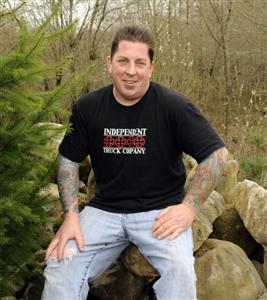 We were introduced to Barry (44) by our friend James Davis of Medford, Oregon. Barry built this truck several years ago but never took it to any shows or left the Washington/Oregon area, so we had never seen it before. The first time we got together to take some photos, we met Barry at a steel warehouse in Portland. Unfortunately, it was dark and rainy that March morning and the pictures didn’t turn out – at least in our opinion – good enough to use. Six months later, we found ourselves back up in Oregon, planning to try again. But, like before, the weather quickly became an issue.
We were introduced to Barry (44) by our friend James Davis of Medford, Oregon. Barry built this truck several years ago but never took it to any shows or left the Washington/Oregon area, so we had never seen it before. The first time we got together to take some photos, we met Barry at a steel warehouse in Portland. Unfortunately, it was dark and rainy that March morning and the pictures didn’t turn out – at least in our opinion – good enough to use. Six months later, we found ourselves back up in Oregon, planning to try again. But, like before, the weather quickly became an issue.
Realizing that we needed to do two photo shoots on the same day because the rain was coming, we quickly hurried up with the first (in Oregon) so we could get on the road and get up to Washington to do the second one (with Barry) that same day. Now, we were fighting not only the rain, but also the impending darkness, as our daylight was fading fast. In 15 years of taking pictures for the magazine, there has only been maybe three times where, after doing a photo shoot, we decided not to use the pictures. This had already happened once with Barry, and we didn’t want it to happen again. But, as luck would have it, everything worked out.
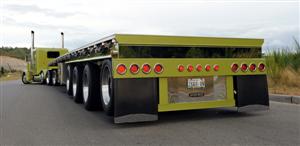 The first group of pictures was taken near the TransAlta Power Generation Station, located just outside of Centralia, Washington (see cover). Later, we found out that this is Washington’s only coal-fired power plant. Then, we rolled back into town and headed to the Sierra Pacific Sawmill, also in Centralia, where we took the rest of the shots, until it got dark. It was one of the more “challenging” photo shoots that we have ever done, but in the end, we think it was all worth it. Still not knowing Barry very well after all this, we had some predetermined ideas about who Barry was and where he came from, but after sitting down to talk with him, we realized that many of those preconceptions were wrong.
The first group of pictures was taken near the TransAlta Power Generation Station, located just outside of Centralia, Washington (see cover). Later, we found out that this is Washington’s only coal-fired power plant. Then, we rolled back into town and headed to the Sierra Pacific Sawmill, also in Centralia, where we took the rest of the shots, until it got dark. It was one of the more “challenging” photo shoots that we have ever done, but in the end, we think it was all worth it. Still not knowing Barry very well after all this, we had some predetermined ideas about who Barry was and where he came from, but after sitting down to talk with him, we realized that many of those preconceptions were wrong.
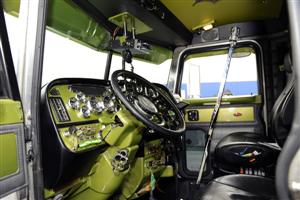 Born in Minnesota, Barry’s family owned a large farm near Grand Forks and grew potatoes, grain and wheat. Wanting to get out of farming and escape all the bugs, his parents, Harlan and Marilyn, packed everything up and moved the family to Tacoma, Washington, where Barry’s dad had got a job at Boeing. After a short time at Boeing, he took a job working at a trucking outfit called Parker Refrigerated, as the shop foreman (his experience on the farm had taught him how to work on heavy equipment). Barry remembers spending a lot of time with his dad at this shop, and at six or seven years old, he started doing odd jobs, like cleaning parts. This was where the trucking “bug” first bit Barry.
Born in Minnesota, Barry’s family owned a large farm near Grand Forks and grew potatoes, grain and wheat. Wanting to get out of farming and escape all the bugs, his parents, Harlan and Marilyn, packed everything up and moved the family to Tacoma, Washington, where Barry’s dad had got a job at Boeing. After a short time at Boeing, he took a job working at a trucking outfit called Parker Refrigerated, as the shop foreman (his experience on the farm had taught him how to work on heavy equipment). Barry remembers spending a lot of time with his dad at this shop, and at six or seven years old, he started doing odd jobs, like cleaning parts. This was where the trucking “bug” first bit Barry.
After leaving Parker Refrigerated, Barry’s dad went to work for a local petroleum outfit as a company driver. He stayed there for a few years and then decided to open up his own truck repair facility in the late 1970s called Emergency Repair Service. Harlan always wanted his shop to be immaculate, so Barry and his two brothers had to clean the white floor, every night, without pay. Barry did not like that!
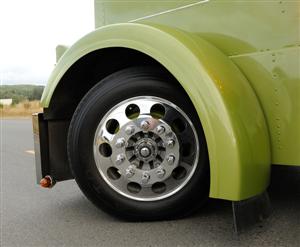 Over the years, some of the customers couldn’t pay their repair bills, and Harlan found himself with a yard full of trucks that he had repossessed. In an effort to take advantage of these rigs, he started hauling some freight, and before long, he started buying even more trucks. Barry learned to drive in his older brother’s 1966 Kenworth with two sticks and “armstrong” steering, and at only 13 years old, remembers doing some driving to help his dad out. At 16, he took this truck on his first solo run, to Portland in a snowstorm. Around 1985, his dad closed the repair shop and started trucking full-time (he called his trucking company ERS). In its heyday, ERS had 15 trucks, but today, Barry’s dad just runs two (and likes it that way).
Over the years, some of the customers couldn’t pay their repair bills, and Harlan found himself with a yard full of trucks that he had repossessed. In an effort to take advantage of these rigs, he started hauling some freight, and before long, he started buying even more trucks. Barry learned to drive in his older brother’s 1966 Kenworth with two sticks and “armstrong” steering, and at only 13 years old, remembers doing some driving to help his dad out. At 16, he took this truck on his first solo run, to Portland in a snowstorm. Around 1985, his dad closed the repair shop and started trucking full-time (he called his trucking company ERS). In its heyday, ERS had 15 trucks, but today, Barry’s dad just runs two (and likes it that way).
After graduating from high school in 1984, Barry went to work full-time for his parents. Back then, they had Kenworths and Freightliners, and Barry mostly ran local, pulling flatbeds, tankers and vans. He worked for his parents for twelve years (from 1982 to 1994). During that time, in 1986, he bought his first truck – a 1979 Ford CLT9000 cabover. This truck was equipped with Ford’s first attempt at an air-ride cab, which was so soft that it practically made Barry sea-sick when he drove it. Barry hated this truck, and said that it looked like Frankenstein. Eventually, he began running out of state, hauling laminated counter tops from Tacoma to Los Angeles, and then whatever he could find back.
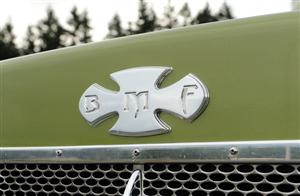 In 1994, Barry decided to venture out, away from the family business, and took a job at a local tanker outfit, as a company driver, for six months. Then, he went to work for a company called Port City Express (PCE), where he ran all over the country – even to Alaska a few times. While working for his parents, he had taken a few loads of dynamite to Fairbanks, Alaska, so he was familiar with the area. Driving for PCE, he started pulling a 53’ 4-axle reefer trailer, and oftentimes took loads of produce into Alaska, as well as running all of the lower 48 states.
In 1994, Barry decided to venture out, away from the family business, and took a job at a local tanker outfit, as a company driver, for six months. Then, he went to work for a company called Port City Express (PCE), where he ran all over the country – even to Alaska a few times. While working for his parents, he had taken a few loads of dynamite to Fairbanks, Alaska, so he was familiar with the area. Driving for PCE, he started pulling a 53’ 4-axle reefer trailer, and oftentimes took loads of produce into Alaska, as well as running all of the lower 48 states.
Barry stayed at Port City Express for about three years, but then the company began to sell off their assets, and then went out of business. Barry was lucky enough to get one of those “assets” – a 1989 Peterbilt 379. He took that truck and went to work for an outfit called KT Charboneau Trucking, out of Rochester, WA. This is where Barry was first introduced to “maxi freight” – loads with gross weights up to 105,500 pounds that require extra axles on the truck and trailer. Back then it was sort of rare, but today, if you want to haul lumber or steel in the Pacific Northwest, you almost have to have a “maxi” setup. He stayed at KT Charboneau for about a year and a half, then, in 1999, he went to Rees Transportation out of Spokane, WA.
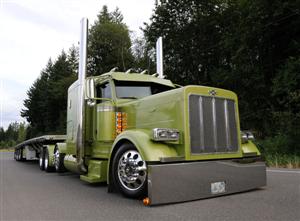 At this point, Barry decided that it was time to step up, so he ordered a new 1999 Peterbilt 379 and a 4-axle Magnum flatbed trailer. This 4-axle truck had a 280-inch wheelbase and was painted a dark metallic blue color. This wasn’t the color that he wanted, but he had ordered the trailer first, before deciding that he wanted a new truck, so he ordered the trailer to match the blue truck he already had. After deciding to buy a new truck, he called the trailer manufacturer to change the color but it was too late – they had already painted it. So, he ordered his new truck blue, even though he really wanted it to be a cool metallic red color that Peterbilt was offering that year. He ran this combo for Rees Transportation for five years, until he ordered his current truck, the one seen on our cover and centerfold this month, as well as on the pages here.
At this point, Barry decided that it was time to step up, so he ordered a new 1999 Peterbilt 379 and a 4-axle Magnum flatbed trailer. This 4-axle truck had a 280-inch wheelbase and was painted a dark metallic blue color. This wasn’t the color that he wanted, but he had ordered the trailer first, before deciding that he wanted a new truck, so he ordered the trailer to match the blue truck he already had. After deciding to buy a new truck, he called the trailer manufacturer to change the color but it was too late – they had already painted it. So, he ordered his new truck blue, even though he really wanted it to be a cool metallic red color that Peterbilt was offering that year. He ran this combo for Rees Transportation for five years, until he ordered his current truck, the one seen on our cover and centerfold this month, as well as on the pages here.
Barry ordered his current truck, a 2005 Peterbilt 379, in early 2004, and took delivery of the uniquely-colored rig in August of that year. The color, derived from a BASF color called Candy Apple Green Metallic that Barry saw on a jet ski, was recreated (minus the candy) by DuPont. The 295-inch long truck is powered by a Cat C-15 with 550 hp, an 18-speed transmission and 3.36 rears. It also has a 48-inch flat top sleeper and a factory drop axle. Knowing that he was going to spend some time and money customizing the truck, he ordered it as bare-boned as possible. When the truck arrived it had no sun visor, the cheapest and shortest stacks available, and a small front bumper. Barry took a month off and spent the entire time working on his new ride.
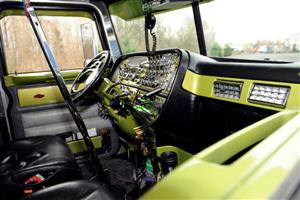 That first month, he did a lot of work to the truck. He installed a painted visor, 5” cab and sleeper extensions, 8-inch pipes with Pickett elbows, painted half-fenders over the drive tires (and drop axles), installed a 20” bumper, and painted the tanks. He also switched out the stock headlight buckets with a set of shaved ones from Pickett Custom Trucks (the turn signals were removed), and then painted them to match. He also installed a 379X grille and grille bars, painted the windshield wiper arms to match, and then had a thin silver metallic accent stripe added down the side of the hood, cab and sleeper. Lastly, he had his trailer painted to match the truck.
That first month, he did a lot of work to the truck. He installed a painted visor, 5” cab and sleeper extensions, 8-inch pipes with Pickett elbows, painted half-fenders over the drive tires (and drop axles), installed a 20” bumper, and painted the tanks. He also switched out the stock headlight buckets with a set of shaved ones from Pickett Custom Trucks (the turn signals were removed), and then painted them to match. He also installed a 379X grille and grille bars, painted the windshield wiper arms to match, and then had a thin silver metallic accent stripe added down the side of the hood, cab and sleeper. Lastly, he had his trailer painted to match the truck.
After taking the month off to customize his new truck, Barry went back to work at Rees Transportation, continuing to do little things to the rig here and there, over the next few years. At some point he installed a 12 Ga. bumper flip kit, had Pickett air bag the front end, he replaced the 5-inch cab and sleeper panels with 9-inch fiberglass extensions, and replaced the stock step boxes with smooth, rounded boxes, made by Trevor Luebbert of Kaufman Metal Works in Tangent, OR. He also did some work inside, like painting the dash and door panels, armrests and steering column, changing the steering wheel, and adding an extra long “twisted stick” shifter from Outlaw Customs. He also had all of the headliner redone in green and custom “hot rod” switches made. The sound system in Barry’s truck has a Pioneer deck, several speakers (including a few large subwoofers), and two amplifiers, but he plans on upgrading to a bigger and louder system sometime soon.
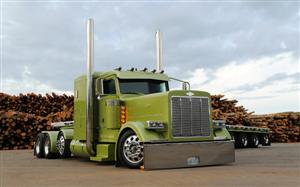 In 2007, Barry decided to leave Rees Transportation and go out on his own, forming Barry Skavlem Transportation. Barry really likes the freedom of owning his own business. Being a true owner operator, he now finds all of his own loads and sets his own schedule. Because of this freedom, Barry is home most nights and weekends, which he loves. A typical day for Barry starts at 2:30 or 3:00 am. Barry likes to get on the road early to beat the traffic and be one of the first to get unloaded at his destination. Then, he has plenty of time to find another load, get reloaded, and start heading back toward home.
In 2007, Barry decided to leave Rees Transportation and go out on his own, forming Barry Skavlem Transportation. Barry really likes the freedom of owning his own business. Being a true owner operator, he now finds all of his own loads and sets his own schedule. Because of this freedom, Barry is home most nights and weekends, which he loves. A typical day for Barry starts at 2:30 or 3:00 am. Barry likes to get on the road early to beat the traffic and be one of the first to get unloaded at his destination. Then, he has plenty of time to find another load, get reloaded, and start heading back toward home.
In February of 2010, Barry took delivery of a new trailer – a 2011 Western “Elite” 4-axle flatbed. Barry had the trailer painted to match the truck, and then had the Pickett boys redo the entire back end by dropping the ICC bar seven inches, building and attaching an extra light bar below the stock one, and then adding some polished stainless panels to fill in all the gaps.
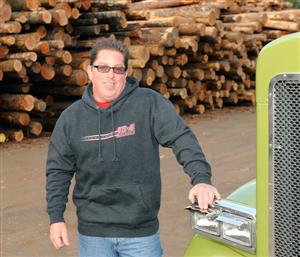 After meeting up with Barry that first time in March, he did a few more things to his truck before we saw him again in August. He replaced and painted his mirror brackets, redesigned and replaced all of his lettering, and added a custom billet emblem on the front, with the letters BMF engraved into it (he claimed that it stands for “Barry Makin’ Friends” but we are not sure if we believe him). He also had Rod Pickett bore out the holes in his aluminum wheels to twice their normal size, giving the truck a whole new (mean) look. Barry still needs to do all the wheels on his trailer, but at $200 each, he’s working on it.
After meeting up with Barry that first time in March, he did a few more things to his truck before we saw him again in August. He replaced and painted his mirror brackets, redesigned and replaced all of his lettering, and added a custom billet emblem on the front, with the letters BMF engraved into it (he claimed that it stands for “Barry Makin’ Friends” but we are not sure if we believe him). He also had Rod Pickett bore out the holes in his aluminum wheels to twice their normal size, giving the truck a whole new (mean) look. Barry still needs to do all the wheels on his trailer, but at $200 each, he’s working on it.
Barry wanted to thank Pickett Custom Trucks and Dan’s Custom Services for all of the hard work they have done on his truck, and Spencer “one ball” Mathis – his neighbor and painter – for all of the great paint work he has done over the years. But the person that Barry wanted to thank the most is his fiancé Jen, who has always been very supportive of his truck habit. Barry and Jen have been together for four years and have two kids, Sydney (3) and Ryan (1). They are planning to get married in September of 2011. Having kids has changed Barry’s entire perspective on life – when he’s not out driving or working on the truck, you’ll find him at home, spending quality time with his kids.
In addition to the new sound system and boring out all the holes in his trailer’s wheels, Barry also plans on installing new doors with shaved handles and electronic door poppers, a larger window in the back of the sleeper that rolls up and down, and fiberglass door panels and speaker boxes inside. He’s also kicking around the idea of adding a second color to the paint scheme. He knows that he doesn’t want to buy a new truck or add any others to his company (he is content with having just one), but he’s had this one for several years now, and he’s thinking it’s about time for a change.
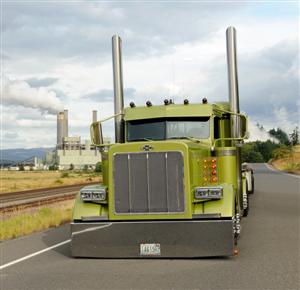 There is one other habit that Barry has acquired over the years – getting tattoos. He currently has full “sleeves” – tattoos completely covering his arms down to the wrists – and is now working on covering his chest. None of his tattoos have any deep meaning – he just gets what he likes at that moment. He just got a large tattoo of two fighting roosters put on his chest, and is currently designing the artwork for his back. Not being an artist, Barry just throws out an idea and then let’s his tattoo guy run with it – and he usually likes what he gets.
There is one other habit that Barry has acquired over the years – getting tattoos. He currently has full “sleeves” – tattoos completely covering his arms down to the wrists – and is now working on covering his chest. None of his tattoos have any deep meaning – he just gets what he likes at that moment. He just got a large tattoo of two fighting roosters put on his chest, and is currently designing the artwork for his back. Not being an artist, Barry just throws out an idea and then let’s his tattoo guy run with it – and he usually likes what he gets.
Barry currently hauls lumber, steel and various building materials all over Oregon and Washington. His truck only has about 600,000 miles on it, and it is still running strong (hauling the “maxi freight” makes up for the lack of miles). He is happy that the Pacific Northwest is finally getting some recognition, because there are a lot of big rides up there in the land of tall trees.
Being quiet and laid back, Barry doesn’t care much about what other people think of him or his truck – he is just out there doing his own thing, following his passion. Getting to know Barry this last year, we realized that not only does he have a “maxi cool” combination, but he is a pretty darn cool guy, too! Thanks for being patient with us, Barry. We hope it was worth the wait for you, because it definitely was for us!
